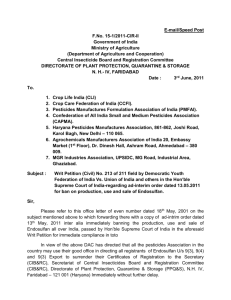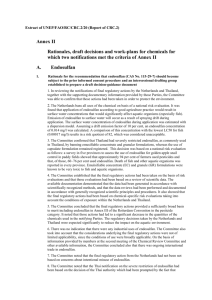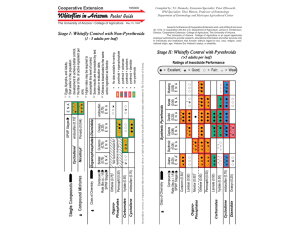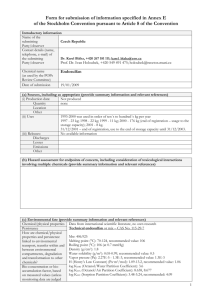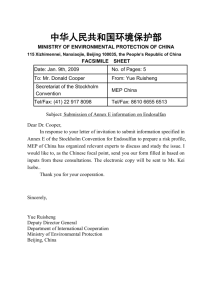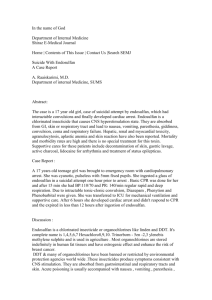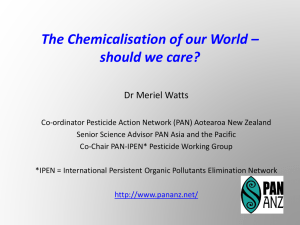Oxidative stress and loss of cortisol secretion in adrenocortical
advertisement
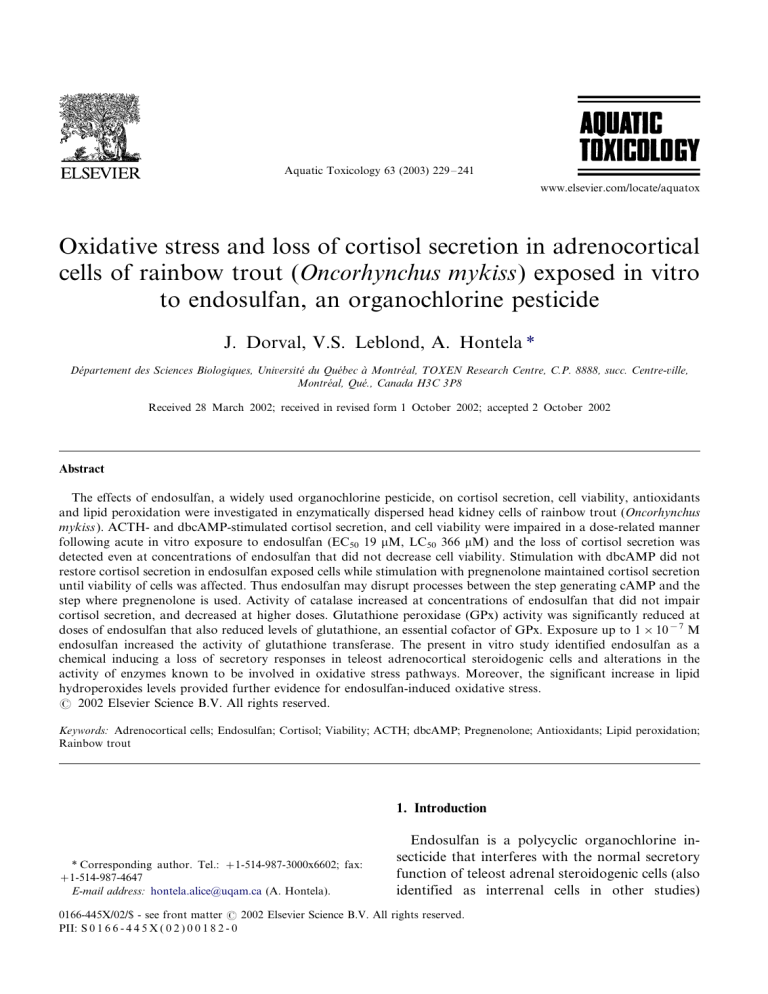
Aquatic Toxicology 63 (2003) 229 /241 www.elsevier.com/locate/aquatox Oxidative stress and loss of cortisol secretion in adrenocortical cells of rainbow trout (Oncorhynchus mykiss) exposed in vitro to endosulfan, an organochlorine pesticide J. Dorval, V.S. Leblond, A. Hontela * Département des Sciences Biologiques, Université du Québec à Montréal, TOXEN Research Centre, C.P. 8888, succ. Centre-ville, Montréal, Qué., Canada H3C 3P8 Received 28 March 2002; received in revised form 1 October 2002; accepted 2 October 2002 Abstract The effects of endosulfan, a widely used organochlorine pesticide, on cortisol secretion, cell viability, antioxidants and lipid peroxidation were investigated in enzymatically dispersed head kidney cells of rainbow trout (Oncorhynchus mykiss ). ACTH- and dbcAMP-stimulated cortisol secretion, and cell viability were impaired in a dose-related manner following acute in vitro exposure to endosulfan (EC50 19 mM, LC50 366 mM) and the loss of cortisol secretion was detected even at concentrations of endosulfan that did not decrease cell viability. Stimulation with dbcAMP did not restore cortisol secretion in endosulfan exposed cells while stimulation with pregnenolone maintained cortisol secretion until viability of cells was affected. Thus endosulfan may disrupt processes between the step generating cAMP and the step where pregnenolone is used. Activity of catalase increased at concentrations of endosulfan that did not impair cortisol secretion, and decreased at higher doses. Glutathione peroxidase (GPx) activity was significantly reduced at doses of endosulfan that also reduced levels of glutathione, an essential cofactor of GPx. Exposure up to 1 /10 7 M endosulfan increased the activity of glutathione transferase. The present in vitro study identified endosulfan as a chemical inducing a loss of secretory responses in teleost adrenocortical steroidogenic cells and alterations in the activity of enzymes known to be involved in oxidative stress pathways. Moreover, the significant increase in lipid hydroperoxides levels provided further evidence for endosulfan-induced oxidative stress. # 2002 Elsevier Science B.V. All rights reserved. Keywords: Adrenocortical cells; Endosulfan; Cortisol; Viability; ACTH; dbcAMP; Pregnenolone; Antioxidants; Lipid peroxidation; Rainbow trout 1. Introduction * Corresponding author. Tel.: /1-514-987-3000x6602; fax: /1-514-987-4647 E-mail address: hontela.alice@uqam.ca (A. Hontela). Endosulfan is a polycyclic organochlorine insecticide that interferes with the normal secretory function of teleost adrenal steroidogenic cells (also identified as interrenal cells in other studies) 0166-445X/02/$ - see front matter # 2002 Elsevier Science B.V. All rights reserved. PII: S 0 1 6 6 - 4 4 5 X ( 0 2 ) 0 0 1 8 2 - 0 230 J. Dorval et al. / Aquatic Toxicology 63 (2003) 229 /241 through mechanisms that have not been elucidated thus far (Leblond et al., 2001; Bisson and Hontela, 2002). It belongs to the group of cyclodienes, chemicals that are potent inhibitors of Na /K and Ca2/Mg2 ATPase, essential for transport of ions across membranes, in mammals as well as in fish (Naqvi and Vaishnavi, 1993). Endosulfan (EPA toxicity class I), is used on a wide variety of food crops including tea, coffee, fruits, as well as cereals, maize and other grains. It may also be used as a wood preservative. The acute toxicity of endosulfan in fish is relatively high (LC50 96 h/ 1.5 mg/l in rainbow trout) (Ferrando et al., 1991), but it does not readily bioaccumulate in tissues (Naqvi and Vaishnavi, 1993; Harris et al., 1998). It is moderately persistent (average field half-life of 50 days) in soils (Wauchope et al., 1992) but it may readily adhere to clay particles and persist in soil and water for several years (Naqvi and Vaishnavi, 1993). Endosulfan poisoning is among the most frequently reported causes of aquatic organism incidents for pesticides. Based on the EPA’s ecological incident information system, the cyclodiene class of insecticides accounted for the third highest percentage of incidents since 1971, and endosulfan accounted for the majority at 62%. Chronic exposure to endosulfan may cause reduced growth, changes in blood chemistry and affect kidneys, liver, intestine and the thyroid gland (Rao et al., 1980; Sastry and Siddiqui, 1982; US ATSDR, 1990). Effects of endosulfan on adrenal function, including the stress response in fish, have not been characterized thus far. Several studies reported that some environmental pollutants can act as endocrine disrupting chemicals (EDCs) in fish (Van der Kraak et al., 1992; Monosson et al., 1994; Olsson et al., 1995). One of the targets of the EDCs seems to be the adrenocortical tissue which secretes corticosteroid hormones (Quabius et al., 1997; Leblond and Hontela, 1999; Benguira and Hontela, 2000). The endocrine disrupting activity of endosulfan in trout adrenocortical cells and the dose-dependant loss of the capacity to secrete cortisol in response to stimulation by ACTH or dbcAMP was demonstrated in a previous study (Leblond et al., 2001). However, the mechanisms through which the secretion of cortisol is impaired by endosulfan have not yet been elucidated. A number of studies provided evidence for the induction of oxidative stress by organochlorine pesticides in liver (Verma et al., 1992; Bagchi and Stohs, 1993; Junquiera et al., 1994), testes (Samanta and Chainy, 1997; Samanta et al., 1999) and cerebral hemisphere (Sahoo et al., 2000) of rat. In fish, modulation of antioxidant systems in liver by endosulfan, and the modulatory effect of preexposure to copper on the endosulfan-induced oxidative stress in vivo have been reported by Pandey et al. (2001). Specially adapted enzymes normally counteract damaging effects of oxidative stress, defined as a disruption of the prooxidant / antioxidant balance in favor of the former, leading to potential damage (Sies, 1991). The main antioxidative enzymes are catalase (CAT) which converts hydrogen peroxide (H2O2) to O2 and H2O, glutathione peroxidase (GPx) which converts H2O2 to H2O, coupled to the oxidation of reduced glutathione (GSH) to oxidized glutathione (GSSG), and superoxide dismutase, which converts O2 to H2O2. Although the antioxidant enzymes have been characterized in fish and bivalves exposed in vivo or in situ at polluted sites (Di Giulio et al., 1993; Thomas and Wofford, 1993; Regoli and Principato, 1995; Solé et al., 1995a,b), the effects of pesticides on the activities of the antioxidant system have not been investigated in the endocrine system of any species, including teleost fish. Adrenocortical tissue has a high content of cytochrome P450s involved in cortisol synthesis. Adrenotoxicants such as pesticides or heavy metals may interact with the catalytic cycle of cytochrome P450s (Hornsby, 1989) and disrupt the cycle to induce formation of reactive oxygen species (ROS) as described by Dawson (1988). Interaction of adrenal EDCs with cytochrome P450s mediating cortisol synthesis may then be responsible, by induction of oxidative stress, for loss of activity of key steroidogenic enzymes such as 11b-hydroxylase, and for cell mortality. The first objective of the present study was to investigate the effects of endosulfan on viability and cortisol secretion of adrenocortical cells stimulated by ACTH, dbcAMP and pregnenolone to J. Dorval et al. / Aquatic Toxicology 63 (2003) 229 /241 identify the intracellular sites of action where the signalling pathway of cortisol secretion is disrupted by endosulfan. The second objective was to characterize the effects of endosulfan on antioxidants and lipid peroxidation to test the hypothesis that the endocrine disrupting effects of endosulfan may be mediated by oxidative stress. 2. Materials and methods 2.1. Chemicals Porcine adrenocorticotropin (ACTH1 39), N ,2?-o-dibutyryladenosine 3?:5?-cyclic monophosphate (dbcAMP), 5-pregnen-3b-ol-20-one (pregnenolone), minimum essential medium (MEM), bovine serum albumin (BSA), Hepes, GSH, reduced a-nicotinamide adenine dinucleotide phosphate, glutathione reductase (GRd), propidium iodide (PI), cumene hydroperoxide, metaphosphoric acid (MPA) and 1-chloro-2,4-dinitrobenzene (CDNB) were purchased from Sigma (St. Louis, MO). Collagenase/dispase mixture (collagenase from Achromobacter iophagus and dispase from Bacillus polymixa ) was obtained from Boehringer Mannheim (Laval, Québec, Canada). RIA kit for cortisol determination and 3-aminobenzoic acid ethyl ester (MS 222) for anesthesia were purchased from ICN Pharmaceuticals (Orangeburg, NY). H2O2, Trypan blue and culture plates (96-well) were obtained from Fisher Scientific (Nepean, Ontario, Canada). Endosulfan was purchased from Riedel de Haën (Diesenhofen, Germany), GSH and LPO assay kits were obtained from Oxis Research Medicorp (Montreal, Québec, Canada). 6 2.2. Experimental animals Juvenile rainbow trout (Oncorhynchus mykiss ) were obtained from La Pisciculture Laurentienne (body weight /100 g). Fish were maintained in a 600-l freshwater tank at 159/1 8C, supplied with a constant flow rate of 3.8 l/min of filtered and oxygen-saturated water (hardness 70 mg/l CaCO3). They were fed daily with commercial trout food at the manufacturer’s recommended rate (10 g/kg of 231 fish). Two weeks of acclimation were allowed before beginning the experiments. 2.3. Preparation of cell suspensions Adrenocortical cell suspensions were prepared as described by Leblond and Hontela (1999). Fish were anesthetized with MS 222 and bled from the caudal vasculature to remove as much blood as possible. Head kidneys were then dissected out and deposited into a tube containing Ringer solution made up with 13.0 g/l NaCl, 0.4 g/l CaCl2, 0.4 g/l KCl, 0.4 g/l NaHCO3, 2.0 g/l dextrose, and 11.9 g/l Hepes at pH 7.4. The tissues were then cut into fragments and washed to remove a maximum of blood cells, resuspended in 2.5 ml of medium containing 2.0 mg/ml collagenase/dispase, and incubated for 60 min with slow agitation at room temperature in a 15 ml polypropylene tube. Following enzymatic digestion, the solution was filtered with a 30 mm mesh cloth and the filtrate, containing individualized cells, was transferred into a 15-ml polypropylene tube and centrifuged at 300 /g (1000 rpm) (IEC Centra-8R centrifuge) for 5 min. The resulting supernatant was then removed and the pellet resuspended in 1.5 ml of Ringer solution. The cellular density was determined and adjusted to 75 /106 cells/ml using a hemacytometer. 2.4. Exposure to pesticide Cells were plated in a 96-well microplate at 150 ml of 75 /106 cells/ml per well. A 2-h preincubation with slow agitation was required to reach a basal cortisol secretion level. The microplate was then centrifuged at 300 /g for 3 min and the supernatants were removed. Cellular pellets were resuspended in 150 ml of Ringer solution with or without toxicant for control wells, and incubated for 60 min at 15 8C. For the experiment, cells were exposed to endosulfan (1 /109, 1 /108, 1 / 107, 1 /106, 1 /105 or 1 /104 M) in Ringer solution. Endosulfan was first dissolved in dimethyl sulfoxide (DMSO) at a final DMSO concentration of 5% v/v. Blanks with DMSO were used to demonstrate that 5% DMSO has no effect on cell viability or cortisol secretion. Following 232 J. Dorval et al. / Aquatic Toxicology 63 (2003) 229 /241 exposure to endosulfan, the plates were centrifuged (300 /g /3 min) and cells were washed with 200 ml of Ringer solution and centrifuged again. 2.5. Stimulation of cortisol secretion and determination of viability After the washing step, pellets were resuspended in 150 ml of MEM supplemented with 5 g/l BSA and 2.2 g/l NaHCO3, pH 7.4 (complete medium) with 2.0 mM dbcAMP, 1 mM pregnenolone or 1 IU/ml ACTH, and incubated at 15 8C for 60 min for ACTH and pregnenolone, and 120 min for dbcAMP. The optimal concentrations of ACTH and dbcAMP, and the incubation times have been validated previously (Leblond and Hontela, 1999). The plate was then centrifuged at 300/g for 3 min. Cortisol secretion was determined by RIA using the supernatants. Viability was assessed by flow cytometry using the exclusion dye PI (1 mg/ ml). To perform the viability test, 5 ml sample from each well of the microplate were resuspended in a test tube containing 370 ml of complete medium to which the PI (1 mg/ml) was added. The cells were analysed using a FACscan (Becton Dickinson), equipped with an argon laser emitting at 488 nm and 10 000 events were analysed for each sample. Data analyses were performed with a Consort 32 system and LYSIS-II program. 2.6. Enzyme assays Enzyme activities and protein concentration were measured after lysis of cells in deionised water. Protein concentration was measured by the dye-binding method of Bradford (1976) using BSA as a standard. CAT activity was measured by the decrease in absorbance at 240 nm (o /0.04/mM/cm) (Ultrospec 2000 Pharmacia Biotech) due to H2O2 consumption, according to Beers and Sizer (1952). The assay was performed using a solution of 12 mM H2O2 containing the cellular lysate in a final volume of 3 ml at 25 8C. One unit of CAT activity was defined as 1 mmol of H2O2 consumed/min/mg of protein. GPx activities were estimated by the decrease in absorbance at 340 nm (o /6.22/mM/cm) due to NADPH oxidation. The activities were assayed in a coupled enzyme system where GSSG is reduced to GSH from excess GRd. The decrease in absorbance was followed in 50 mM Tris /phosphate buffer (pH 7.6) containing 0.1 mM EDTA, 2.4 mM GSH, 1 unit GRd, 0.16 mM NADPH and 2.4 mM cumene hydroperoxide (adapted from Tappel, 1978). One unit of GPx activity was defined as 1 nmol of NADPH oxidized/min/mg of protein. Glutathione-S-transferase (GST) activity was determined at 340 nm using CDNB as substrate (o /9.6/mM/cm) as described by Habig et al. (1974). Several isoenzyme of GST exist with distinct but overlapping substrate specificities and CDNB is conjugated much more rapidly than any other substrate (Machala et al., 1998). The assay was carried out in a solution of 100 mM Na-phosphate buffer (pH 6.5), 2 mM CDNB, 2 mM GSH containing the cellular lysate in a final volume of 1 ml. One unit of GST activity was defined as 1 mmol of GSH consumed/min/mg of protein. 2.7. Reduced glutathione levels GSH levels were measured using the GSH-400 method (Oxis Research Medicorp) based on a chemical reaction which proceeds in two steps, the formation of substitution products (thioethers) between 4-chloro-1-methyl-7-trifluoromethyl-quinolinium (reagent) and all mercaptans which are present in the sample, and a b-elimination reaction that specifically transforms the substitution product (thioethers) obtained with GSH into a chromophoric thione which has a maximal absorbance wavelength at 400 nm. 2.8. Lipid peroxides levels determination Lipid hydroperoxides (LOOH) levels were determined using the LPO-560 method (Oxis Research Medicorp) based on a direct colorimetric measurement of LOOH. The assay is based on the oxidation of ferrous ions to ferric ions by hydroperoxides and the binding of ferric ions to the J. Dorval et al. / Aquatic Toxicology 63 (2003) 229 /241 indicator dye, xylenol orange, to form a stable, colored complex that can be measured at 560 nm. To eliminate H2O2 interference from the LOOH measurement, the samples are pretreated with CAT and a sample blank is assayed to quantitate and substract the non-LOOH produced 560 nm signal. 2.9. Statistics Data correspond to the average of at least three replicates. Statistical differences between responses of exposed cells and non-exposed controls were checked using a one-way analysis of variance with a confidence range of P B/0.05. Differences between cortisol secretion stimulated by ACTH, dbcAMP and pregnenolone and differences in enzymatic activities between exposed and nonexposed cells were assessed using Student’s and Tukey-Kramer tests (a /0.05). The EC50 and LC50 were determined using the best fitting polynomial model with JUMPIN software model. 3. Results 3.1. Cortisol secretion and cell viability The responses of ACTH-, dbcAMP- or pregnenolone-stimulated adrenocortical cells to an in vitro exposure to endosulfan are shown in Fig. 1. The data are expressed as a percentage of control (cells not exposed to endosulfan). Cell viability was impaired in a dose-related manner following exposure to endosulfan with 5% decrease at 1/ 105 M, 20% decrease at 1/104 M and 60% at 5 /104 M. The mean (9/SEM) values of cortisol secretion in ACTH-, dbcAMP- and pregnenolonestimulated controls were respectively 24.719/ 13.24, 11.339/3.86 and 30.569/16.86 ng/ml. Cortisol secretion in response to ACTH or dbcAMP stimulation was also impaired in a dose-related manner following exposure to endosulfan. Exposure to 1 /109, 1 /108, 1/107 and 1/ 106 M of endosulfan had no significant effect on cortisol secretion while ACTH- and dbcAMPstimulated cortisol secretion were significantly decreased at 1/105 and 1 /10 4 M (by 48 233 and 64%, respectively, compared to control). While stimulation with dbcAMP could not restore the secretory response, no significant differences in cortisol secretion were observed between pregnenolone-stimulated cells exposed to endosulfan at 1/109 to 1 /105 M and non-exposed controls. Cortisol secretion was significantly decreased by 90% of controls at 1 /104 M endosulfan, the same dose that significantly decreased cell viability by over 20%. The median effective concentration of endosulfan (EC50, the dose that inhibits ACTH-stimulated cortisol secretion by 50%) and the median lethal concentration (LC50, the dose that kills 50% of the cells) were respectively 19 and 366 mM. 3.2. Antioxidative enzymes activities CAT, GPx and GST activities of ACTH-stimulated adrenocortical cells after 60 min exposure in vitro to endosulfan are shown in Fig. 2. The data are expressed as a percentage of non-exposed ACTH-stimulated controls. Parameters of each enzyme kinetic have been previously determined to obtain the optimal enzymatic reaction. Table 1 shows the enzymatic activities of non-exposed controls after 30, 60 and 120 min incubation in Ringer solution. Incubation period of 60 min was sufficient to induce optimal enzymatic activities and was therefore selected for the experiments with endosulfan, so that the results could be interpreted in relation with cortisol secretion and viability, also determined after 60 min. Incubation of 60 min was necessary to reach maximal cortisol secretion with the optimal dose of ACTH in a previous study (Leblond et al., 2001). The data are expressed in international units corresponding to one mmol of substrate consumed or product formed/min/mg of protein. The general pattern of CAT, GPx and GST activities following 30, 60 or 120 min in vitro exposure to endosulfan were similar (data not shown). CAT activity (Fig. 2A) was significantly increased at 1 /10 7 and 1 /10 6 M of endosulfan (116 and 128%, respectively, compared to nonexposed control). CAT activity was however reduced by 24% at 1 /105 M and 60% at 1 / 104 M, concentrations at which cortisol secretion 234 J. Dorval et al. / Aquatic Toxicology 63 (2003) 229 /241 Fig. 1. Cortisol secretion by adrenocortical cells (mean9/SE) exposed in vitro to 1/10 9, 1/10 8, 1/10 7, 1/10 6, 1/10 5, 1/10 4 or 5/10 4 M endosulfan for 60 min and subsequently stimulated with 1.0 IU/ml ACTH (squares), 2.0 mM dbcAMP (triangles) or 1 mM pregnenolone (circles) at 15 8C. Cell viability, assessed by flow cytometry using the exclusion dye PI (FACscan) method following exposure to endosulfan is indicated by losanges. *Indicates significant differences from non-exposed controls (Student’s and Tukey-Kramer test, a/0.05). Adrenocortical cells obtained from the interrenal tissue of one fish correspond to n/1 and the number of fish is 8. (Figs. 1 and 2A) was significantly reduced and almost undetectable at the highest concentration. Exposure up to 1 /107 M of endosulfan had no significant effects on GPx activity (Fig. 2B) while a significant reduction by 53% at 1 /106 M, 69% at 1 /105 M and 81% at 1/104 M was observed. GST activity (Fig. 2C) was significantly increased at 1/109, 1/108 and 1 /107 M (124, 128 and 140% of non-exposed control respectively). No significant differences in GST were observed between exposed cells and nonexposed controls at 1 /106 M and higher concentrations of endosulfan. 3.3. Reduced glutathione levels GSH levels were measured in ACTH-stimulated adrenocortical cells after 60 min exposure to endosulfan. The apparent molar extinction coefficient (o ) was determined using a GSH 0.5 mmol/l in 5% MPA solution as standard. GSH levels decreased in a dose-related manner as shown on Fig. 3 and were significantly reduced at 1/107 and 1 /106 M endosulfan (45% of control) and at 1 /105 M (7% of control). At 1 /104 M endosulfan, GSH levels were undetectable. 3.4. Lipid hydroperoxides levels LOOH levels were significantly increased at 1 / 107, 1/106 and 1 /104 M endosulfan (110, 118 and 109% of non-exposed control respectively) as shown in Fig. 4. 4. Discussion The present study demonstrated that endosulfan, an organochlorine pesticide from the group of cyclodienes, interferes with the normal secretory function of adrenocortical steroidogenic cells and induces alterations in the activity of enzymes mediating the oxidative stress defence. To identify the intracellular sites of action of endosulfan in the adrenocortical cells, the effects of endosulfan on ACTH-, dbcAMP- and pregnenolone-stimulated cortisol secretion and cell viability were evaluated in vitro in enzymatically J. Dorval et al. / Aquatic Toxicology 63 (2003) 229 /241 Fig. 2 235 J. Dorval et al. / Aquatic Toxicology 63 (2003) 229 /241 236 Fig. 3. GSH levels (mean9/SE, expressed as % of non-exposed control) in adrenocortical cells after 60 min exposure to 1/10 9, 1/ 10 8, 1/10 7, 1/10 6, 1/10 5 or 1 /10 4 M endosulfan and subsequently stimulated with 1.0 IU/ml ACTH at 15 8C. GSH levels are represented by losanges and cortisol secretion by squares. *Indicates significant differences from control (Student’s and Tukey-Kramer tests, a /0.05). Adrenocortical cells of one fish correspond to n/1 and the number of fish is 8. Table 1 CAT, GPx and glutathione-S -transferase (GST) activities (mean9/SE) in adrenocortical cells of rainbow trout (Oncorhynchus mykiss ) after 30, 60 or 120 min incubation in Ringer solution following a 1 IU/ml ACTH stimulation Incubation time (min) CAT GPx GST 30 60 120 13.989/5.44 19.549/11.66 9.269/2.68 43.079/18.81 44.149/19.19 51.269/35.88 28.489/7.01 20.489/7.59 21.399/9.34 Mean values9/SE are expressed in U/mg protein/min (CAT and GST) and mU/mg protein/min (GPx). Cells obtained from the interrenal tissue of one fish corresponds to n/1 and the number of fish is 8. dispersed head kidney cells of rainbow trout (Oncorhynchus mykiss ). The measure of cell viability was important to assess whether the loss of secretory function was due to effects of endosulfan on cortisol biosynthesis pathway or to cell death. The difference in the decrease of cortisol secretion and viability at 1 /105 M endosulfan (40 and 5%, respectively) suggests that endosulfan mediates its adrenotoxic effects mostly through disruption of cortisol synthesis, rather than by inducing death of the adrenocortical cells. Our results confirm a previous study by Leblond et al. (2001) providing evidence that endosulfan interferes with cortisol synthesis in teleost steroidogenic cells at doses that are not cytotoxic. Stimulation by dbcAMP, an analog of cAMP, could not restore cortisol secretion in cells exposed to endosulfan, suggesting an action of endosulfan at a site situated downstream from the step generating cAMP in the cortisol-secreting cells (Fig. 1). The same effects were observed in rainbow trout steroidogenic cells exposed in vitro to heavy metals (cadmium, mercury and zinc) while o,p ?-DDD seemed to impair a step located between ACTH binding and the step generating cAMP (Ilan and Yaron, 1980; Leblond and Hontela, 1999). Fig. 2. CAT (A), GPx (B) and GST (C) activities (mean9/SE, expressed as % of non-exposed control) in adrenocortical cells exposed in vitro to 1/10 9, 1/10 8, 1/10 7, 1/10 6, 1/10 5 or 1/10 4 M endosulfan for 60 min and subsequently stimulated with 1.0 IU/ml ACTH at 15 8C. Enzyme activities are represented by losanges and cortisol secretion, reported from Fig. 1, is also shown (squares). *Indicates significant differences from control (Student’s and Tukey-Kramer tests, a/0.05). Adrenocortical cells of one fish correspond to n/1 and the number of fish is 8. Each point corresponds to the average of at least 3 replicates by fish and by dose of endosulfan. J. Dorval et al. / Aquatic Toxicology 63 (2003) 229 /241 237 Fig. 4. LOOH levels (mean9/SE, expressed as % of non-exposed control) in adrenocortical cells after 60 min exposure to 1/10 9, 1/10 8, 1/10 7, 1/10 6, 1 /10 5 or 1/10 4 M endosulfan and subsequently stimulated with 1.0 IU/ml ACTH at 15 8C. *Indicates significant differences from control (Student’s and Tukey-Kramer tests, a /0.05). Adrenocortical cells of one fish correspond to n/1 and the number of fish is 8. In addition to ACTH and dbcAMP, pregnenolone, a product of the side chain cleavage reaction following the rate limiting step of mitochondrial cholesterol translocation, was used as a substrate in the present study to test the integrity of the enzymatic cascade involved in cortisol synthesis. Cortisol secretion in pregnenolone-stimulated steroidogenic cells exposed to endosulfan was not significantly different from non-exposed control, until cytotoxic doses of endosulfan at which viability of cells was impaired were used (Fig. 2). These results suggest that a step upstream from pregnenolone formation was impaired. Recent studies provided evidence that pesticides such as Roundup or lindane, the g isomer of hexachlorocyclohexane, inhibit steroidogenesis by disrupting the steroidogenic acute regulatory (StAR) protein expression (Walsh et al., 2000; Walsh and Stocco, 2000). This protein, characterized by Stocco and Clark (1996), is involved in the transfer of cholesterol to the inner mitochondrial membrane where the cytochrome P450 side chain cleavage enzyme initiates the synthesis of all steroid hormones. Endosulfan may disrupt cortisol steroidogenesis through mechanisms similar to those of Roundup or lindane. Effects of endosulfan on the ACTH receptor cannot be excluded at present. Endosulfan may indeed impair membrane integrity and function by damaging receptors and ion channels within the membrane. Endosulfan has been characterized as a potent inhibitor of ATPase, essential for transport of Ca2 across membranes (Naqvi and Vaishnavi, 1993). To elucidate the mechanisms through which endosulfan disrupts cortisol steroidogenesis, the effects of endosulfan on the antioxidant defence system were investigated in adrenocortical cells. Oxidative stress is a result of one of three factors: (1) an increase in ROS, (2) an impairment of antioxidant defence systems, or (3) a default to repair oxidative damage. The main damage induced by ROS results in alterations of cellular macromolecules (membrane lipids, proteins and DNA) and of cell function such as changes in intracellular calcium and intracellular pH, or cell death (Masaki et al., 1989; Kehrer et al., 1990; Swann et al., 1991). A number of recent studies provided evidence for the capacity of organochlorine pesticides (endrin, HCH, lindane and others) to induce oxidative stress in different organs (Singh and Pandey, 1989; Bagchi et al., 1993a,b, 1995; Hincal et al., 1995; Hassoun and Stohs, 1996; Bachowski et al., 1998). However, the role of oxidative stress in endocrine toxicity has not been investigated thus far. Our study is the first report on the action of an organochlorine pesticide, 238 J. Dorval et al. / Aquatic Toxicology 63 (2003) 229 /241 endosulfan, on the antioxidant system in teleost adrenocortical tissue. A significant increase of CAT activity was observed at doses of endosulfan that had no effect on cortisol secretion, while at higher doses of endosulfan, CAT activity was reduced and cortisol secretion impaired (Fig. 2A). CAT, an enzyme mostly localized in peroxisomes is, with the glutathione redox cycle, the primary cellular enzymatic defence system against H2O2, converting it into H2O and O2. GSH levels decreased in a dose-related manner following in vitro exposure to endosulfan (Fig. 3). GSH is an essential antioxidant that acts either directly as a reductant or as a substrate for antioxidant enzymes and ensures the reduction of oxidants and the neutralization of peroxides. GSH is therefore not only an essential cofactor of several enzymes such as GST and GPx but it is also a direct scavenger of oxiradicals (Winston et al., 1998; Regoli and Winston, 1999). The deficiency of the antioxidative system and the alterations in the activity of enzymes involved in oxidative stress observed in our system is likely to affect the capacity of cells to defend themselves and respond to contaminant-induced oxidative stress. Indeed, if detoxification of H2O2 to H2O by GPx is impaired, a part of excess H2O2 may be converted to toxic hydroxyl radicals through the Fenton reaction, depending on free transition metal concentrations (Kehrer, 2000). Thus, GPx and CAT are critical for the process of scavenging free radicals. An impairment in antioxidative enzymes will produce an imbalance between pro and antioxidant systems causing the formation of toxic hydroxyl radicals with direct consequences on cell integrity and cell function itself (namely, loss of capacity to secrete cortisol in response to stimulation by ACTH and dbcAMP). If oxidative species are not rapidly eliminated, loss of physiological integrity of the cell may induce an impairment of its capacity to survive, a phenomenon observed at high doses of endosulfan (Fig. 1), at the concentrations where CAT and GPx activities are greatly reduced. The significant increase in LOOH levels (Fig. 4) provided further evidence for endosulfan-induced oxidative stress. Lipid peroxidation is a wellrecognized mechanism of cellular injury used as an indicator of oxidative stress in cells and tissues. Reactive aldehydes generated during the process of lipid peroxidation, unlike reactive free radicals, can diffuse from the site of their origin and reach and damage intra- and extra-cellular targets, distant from the initial free radical event (Esterbauer et al., 1990). Several enzymatic systems such as phase I or II biotransformation enzymes are activated during exposure to contaminants and facilitate detoxification. Increase in the enzymatic activities of GST has been used as a marker of exposure to organochlorine contaminants (Machala et al., 1998). Little is known about the nature and function of GST in fish. In mammals, GST greatly enhances its own activity by sulfhydryl-reactive metabolites and reduced oxygen species during oxidative stress (Moorhouse and Casida, 1992; Aniya et al., 1993). GST participates in pollutant-detoxification by adding a GSH-group to these compounds or their metabolites so they become more water-soluble and easily excretable. Significant increase of GST activity observed following exposure to endosulfan provides evidence for the role of this enzyme in defence in fish adrenocortical cells (Fig. 2C). In conclusion, this in vitro study suggested that multiple sites may be affected by endosulfan within the steroidogenic cells. Stimulation of endosulfan-exposed cells with dbcAMP and pregnenolone, provided evidence that endosulfan disrupts the cortisol-secretory response at sites situated downstream from the step generating cAMP and upstream of pregnenolone formation. Furthermore, our results demonstrated for the first time, oxidative stress induced by endosulfan in adrenocortical cells of rainbow trout. Endosulfan exposure may affect several components in the cortisol synthesis pathway including StAR protein and may, at the same time, interact directly with the steroidogenic enzyme machinery. Endosulfan may also affect the adrenocortical cells function by inducing oxidative stress and altering the activities of enzymes involved in oxidative stress defense. Further investigations are required to identify the intracellular targets of oxidative stress induced following the exposure to contaminants and to elucidate the processes through which endocrine disruptors such as pesticides impair adrenal steroidogenesis. Consequences of endosulfan-induced J. Dorval et al. / Aquatic Toxicology 63 (2003) 229 /241 oxidative stress on target organs other than the adrenal tissue also need to be assessed. Mechanism-based understanding of exposure-effect relationships is an integral part of risk assessment. Acknowledgements We wish to thank A. Lacroix, A. Gravel, M. Lacroix and B. Goulet for help throughout the study. This study was funded by the Reproductive and Endocrine Toxicology Program of CNTC (Canadian Network for Toxicology Centers), by NSERC POG 0139183 to A.H. (Natural Sciences and Engineering Council of Canada) and TOXEN Research Centre (bursary to J. Dorval). References Aniya, Y., Shimoji, M., Naito, A., 1993. Increase in liver microsomal glutathione-S -transferase activity by phenobarbital treatment of rats. Biochem. Pharmacol. 46, 1741 / 1747. Bachowski, S., Xu, Y., Stevenson, D.E., Walborg, E.F., Klaunig, J.E., 1998. Role of oxidative stress in the selective toxicity of dieldrin in the mouse liver. Toxicol. Appl. Pharmacol. 150, 301 /309. Bagchi, M., Hassoun, E.A., Akubue, P., Bagchi, D., Stohs, S.J., 1993a. Comparative effects of endrin on hepatic lipid peroxidation and DNA damage, and nitric oxide production by peritoneal macrophages from C57BL/6J and DBA/2 mice. Comp. Biochem. Physiol. 105C, 525 /529. Bagchi, D., Hassoun, E.A., Bagchi, M., Stohs, S.J., 1993b. Protective effects of antioxidants against endrin-induced hepatic lipid peroxidation, DNA damage and excretion of urinary lipid metabolites. Free Rad. Biol. Med. 15, 217 / 222. Bagchi, M., Stohs, S.J., 1993. In vitro induction of reactive oxygen species by 2,3,7,8-tetrachlorodibenzo-p -dioxin, endrin and lindane in rat peritoneal macrophages and hepatic mitochondria and microsomes. Free Rad. Biol. Med. 14, 11 /18. Bagchi, D., Bagchi, M., Hassoun, E.A., Stohs, S.J., 1995. In vitro and in vivo generation of reactive oxygen species, DNA damage and lactate dehydrogenase leakage by selected pesticides. Toxicology 104, 129 /140. Beers, R.F., Jr., Sizer, I.W., 1952. Spectrophotometric method for measuring the breakdown of hydrogen peroxide by catalase. J. Biol. Chem. 195, 133 /140. Benguira, S., Hontela, A., 2000. Adrenocorticotrophin- and cyclic adenosine 3?, 5?-monophosphate-stimulated cortisol secretion in interrenal tissue of rainbow trout exposed in 239 vitro to DDT compounds. Environ. Toxicol. Chem. 19, 842 /847. Bisson, M., Hontela, A., 2002. Cytotoxic and endocrinedisrupting potential of atrazine, diazinon, endosulfan and mancozeb in adrenal steroidogenic cells of rainbow trout exposed in vitro. Toxicol. Appl. Pharmacol. 180, 110 /117. Bradford, M.M., 1976. A rapid and sensitive method for the quantitation of microgram quantities of protein utilizing the principle of protein-dye binding. Anal. Biochem. 72, 248 / 254. Dawson, J.H., 1988. Probing structure /function relations in heme-containing oxygenases and peroxydases. Science 240, 433 /439. Di Giulio, R.T., Habig, C., Gallagher, E.P., 1993. Effects of black rock harbor sediments on indices of biotransformation, oxidative stress, and DNA integrity in channel catfish. Aquat. Toxicol. 26, 1 /22. Esterbauer, H., Zollner, H., Schaur, R.J., 1990. In: VigoPelfrey, C. (Ed.), Membrane Lipid Peroxidation, vol. 1. CRC Press, Boca Raton, pp. 239 /268. Ferrando, M.D., Sancho, E., Andreu-Moliner, E., 1991. Comparative acute toxicities of selected pesticides to Anguilla anguilla. J. Environ. Sci. Health 26B, 491 /498. Habig, W.H., Pabst, M.J., Jakoby, W.B., 1974. Glutathione S transferase. The first enzymatic step in mercapturic acid formation. J. Biol. Chem. 249, 7130 /7139. Harris, M.L., Bishop, C.A., Struger, J., Van Den Heuvel, M.R., Van Der Kraak, G.J., Dixon, D.G., Ripley, B., Bogart, J.P., 1998. The functional integrity of northern leopard frog (Rana pipiens ) and green frog (Rana clamitans ) populations in orchard wetlands. I. Genetics, physiology, and biochemistry of breeding adults and young-of-the-year. Environ. Toxicol. Chem. 17, 1338 /1350. Hassoun, E., Stohs, S.J., 1996. TCDD, endrin and lindane induced oxidative stress in foetal and placental tissues of C57BL/6J and DBA/2J mice. Comp. Biochem. Physiol. 115C, 11 /18. Hincal, F., Gurbay, A., Giray, B., 1995. Induction of lipid peroxidation and alteration of glutathione redox status by endosulfan. Biol. Trace Elem. Res. 47, 321 /326. Hornsby, P.J., 1989. Steroid and xenobiotic effects on the adrenal cortex: mediation by oxidative and other mechanisms. Free Rad. Biol. Med. 6, 103 /115. Ilan, Z., Yaron, Z., 1980. Stimulation of cortisol secretion in vitro from the interrenal tissue of the cichlid fish, Sarotherodon aureus, by adrenocorticotropin or cyclic AMP. J. Endocrinol. 86, 269 /277. Junquiera, V.B., Bainy, A.C., Arisi, A.C., Azzalis, L.A., Simizu, K., Pimental, R., Barros, S.B., Videla, L.A., 1994. Acute lindane intoxication: a study of lindane tissue concentration and oxidative stress-related parameters in liver and erythrocytes. J. Biochem. Toxicol. 9, 9 /15. Kehrer, J.P., Jones, D.P., Lemasters, J.J., Farber, J.L., Jaeschke, H., 1990. Summary of the Symposium Presented at the 1990 Annual Meeting of the Society of Toxicology. Toxicol. Appl. Pharmacol. 106, 165 /178. 240 J. Dorval et al. / Aquatic Toxicology 63 (2003) 229 /241 Kehrer, J.P., 2000. The Haber-Weiss reaction and mechanisms of toxicity. Toxicology 149, 43 /50. Leblond, V.S., Hontela, A., 1999. Effects of in vitro exposures to cadmium, mercury, zinc, and 1-(2-chlorophenyl)-1-(4chlorophenyl)-2,2-dichloroethane on steroidogenesis by dispersed interrenal cells of rainbow trout (Oncorhynchus mykiss ). Toxicol. Appl. Pharmacol. 157, 16 /22. Leblond, V.S., Bisson, M., Hontela, A., 2001. Inhibition of cortisol secretion in dispersed head kidney cells of rainbow trout (Oncorhynchus mykiss ) by endosulfan, an organochlorine pesticide. Gen. Comp. Endocrinol. 121, 48 /56. Machala, M., Drabek, P., Neca, J., Kolarova, J., Svobodova, Z., 1998. Biochemical markers for differentiation of exposures to nonplanar polychlorinated biphenyls, organochlorine pesticides, or 2,3,7,8-tetrachlorodibenzo-p -dioxin in trout liver. Ecotox. Environ. Safety 41, 107 /111. Masaki, N., Thomas, A.P., Hoekj, J.B., Farber, J.L., 1989. Intracellular acidosis protects cultured hepatocytes from the toxic consequences of a loss of mitochondrial energization. Arch. Biochem. Biophys. 272, 152 /161. Monosson, E., Fleming, W.J., Sullivan, C.V., 1994. Effects of the planar PCB 3,3?,4,4?-tetrachlorobiphenyl (TCB) on ovarian development, plasma levels of sex steroid hormones and vitellogenin, and progeny survival in the white perch (Morone americana ). Aquat. Toxicol. 29, 1 /19. Moorhouse, K.G., Casida, J.E., 1992. Pesticides as activators of mouse liver microsomal glutathione-S -transferase. Pestic. Biochem. Physiol. 44, 83 /90. Naqvi, S.M., Vaishnavi, C., 1993. Bioaccumulative potential and toxicity of endosulfan insecticide to non-target animals. Comp. Biochem. Physiol. 105C, 347 /361. Olsson, P.E., Kling, P., Petterson, C., Silversand, C., 1995. Interaction of cadmium and oestradiol-17b on metallothionein and vitellogenin synthesis in rainbow trout (Oncorhynchus mykiss ). Biochem. J. 307, 197 /203. Pandey, S., Ahmad, I., Parvez, S., Bin-Hafeez, B., Haque, R., Raisuddin, S., 2001. Effect of endosulfan on antioxidants of freshwater fish Channa punctatus Bloch: 1. Protection against lipid peroxidation in liver by copper preexposure. Arch. Environ. Contam. Toxicol. 41, 345 /352. Quabius, E.S., Balm, P.H.M., Wendelaar Bonga, S.E., 1997. Interrenal stress responsiveness of Tilapia (Oreochromis mossambicus ) is impaired by dietary exposure to PCB 126. Gen. Comp. Endocrinol. 108, 472 /482. Rao, D.M.R., Devi, A.P., Murty, A.S., 1980. Relative toxicity of endosulfan, its isomers and formulated products to the fresh water fish Labeo rohita. J. Toxicol. Environ. Health 6, 825 /834. Regoli, F., Principato, G., 1995. Glutathione, glutathionedependent and antioxidant enzymes in mussel, Mytilus galloprovincialis , exposed to metals under field and laboratory conditions: implications for the use of biochemical biomarkers. Aquat. Toxicol. 31, 143 /164. Regoli, F., Winston, G.W., 1999. Quantification of total oxidant scavenging capacity (TOSC) of antioxidants for peroxynitrite, peroxyl radicals and hydroxyl radicals. Toxicol. Appl. Pharmacol. 156, 96 /105. Sahoo, A., Samanta, L., Chainy, G.B.N., 2000. Mediation of oxidative stress in HCH-induced neurotoxicity in rat. Arch. Environ. Contam. Toxicol. 39, 7 /12. Samanta, L., Chainy, G.B.N., 1997. Comparison of hexachlorocyclohexane-induced oxidative stress in the testis of immature and adult rats. Comp. Biochem. Physiol. 118C, 319 /327. Samanta, L., Sahoo, A., Chainy, G.B.N., 1999. Age-related changes in rat testicular oxidative stress parameters by hexachlorocyclohexane. Arch. Toxicol. 73, 96 /107. Sastry, K.V., Siddiqui, A.A., 1982. Effect of endosulfan and quinalphos on intestinal absorption of glucose in the freshwater murrel, Channa punctatus . Toxicol. Lett. 12, 289 /293. Sies, H., 1991. Oxidative stress: introduction. In: Sies, H. (Ed.), Oxidative Stress: Oxidants and Antioxidants, vol. 23. Academic Press, San Diego, pp. 21 /48. Singh, S.K., Pandey, R.S., 1989. Toxicity of endosulfan on kidney of male rats in relation to drug metabolising enzymes and microsomal lipid peroxidation. Ind. J. Exp. Biol. 27, 725 /728. Solé, M., Porte, C., Albaiges, J., 1995a. The use of biomarkers for assessing the effects of organic pollution in mussels. Sci. Total Environ. 159, 147 /153. Solé, M., Porte, C., Albaiges, J., 1995b. Seasonal variation in the mixed-function oxidase system and antioxidant enzymes of the mussel Mytilus galloprovincialis . Environ. Toxicol. Chem. 14, 157 /164. Stocco, M.D., Clark, B.J., 1996. Regulation of the acute production of steroids in steroidogenic cells. Endocr. Rev. 17, 221 /244. Swann, J.D., Smith, M.W., Phelps, P.C., Maki, A., Berezesky, I.K., Trump, B.F., 1991. Oxidative injury induces influxdependent changes in intracellular calcium homeostasis. Toxicol. Pathol. 19, 128 /137. Tappel, A.L., 1978. Glutathione peroxidase and hydroperoxydes. Methods Enzym. 52, 506 /513. Thomas, P., Wofford, H.W., 1993. Effects of cadmium and Aroclor 1254 on lipid peroxidation, glutathione peroxidase activity, and selected antioxidants in Atlantic croaker tissues. Aquat. Toxicol. 27, 159 /178. US Agency for Toxic Substances and Disease Registry, 1990. Toxicological profile for endosulfan. Draft report. Atlanta, pp. 6 /52. Van der Kraak, G.J., Munkittrick, K.R., McMaster, M.E., Portt, C.B., Chang, J.P., 1992. Exposure to bleached kraft pulp mill effluent disrupts the pituitary-gonadal axis of white sucker at multiple sites. Toxicol. Appl. Pharmacol. 115, 224 /233. Verma, S.P., Rastogi, A., Lin, P., 1992. Hexachlorocyclohexane pesticides reduce survival and alter plasma membrane structure of Chinese hamster V79 cells. Arch. Biochem. Biophys. 298, 587 /593. Walsh, L.P., Stocco, D.M., 2000. Effects of lindane on steroidogenesis and steroidogenic acute regulatory protein expression. Biol. Reprod. 63, 1024 /1033. J. Dorval et al. / Aquatic Toxicology 63 (2003) 229 /241 Walsh, L.P., McCormick, C., Martin, C., Stocco, D.M., 2000. Roundup inhibits steroidogenesis by disrupting steroidogenic acute regulatory (StAR) protein expression. Environ. Health Perspect. 108 (8), 769 /776. Wauchope, R.D., Buttler, T.M., Hornsby, A.G., Augustijn Beckers, P.W.M., Burt, J.P., 1992. Pesticide properties 241 database for environmental decision making. Rev. Environ. Contam. Toxicol. 123, 6 /15. Winston, G.W., Regoli, F., Dugas, A.J., Fong, J.H., Blanchard, K.A., 1998. A rapid gas-chromatographic assay for determining oxyradical scavenging capacity of antioxidants and biological fluids. Free Rad. Biol. Med. 24, 480 /493.
